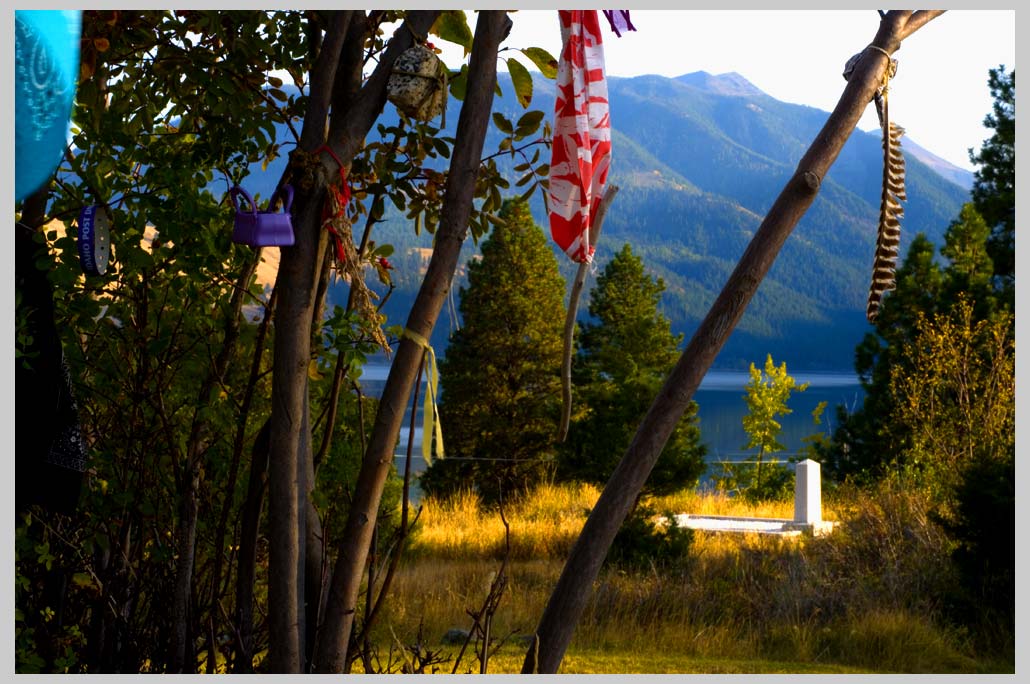

GRAVESITE, Tu-eka-kas (c. 1785-1871) CHIEF JOSEPH the Elder—
looking Southeast towards Signal Peak, [click photo for next . . . ]
(so-called "Mt. Howard")


GRAVESITE, Tu-eka-kas (c. 1785-1871) CHIEF JOSEPH the Elder—
looking Southeast towards Signal Peak, [click photo for next . . . ]
(so-called "Mt. Howard")
Hinmaton-Yalakit (Young Chief Joseph)
“I blame my young men and I blame the white men.
I blame General Howard for not giving
my people the time to get their stock away
from the Wallowa. It is still our land.
It may never be our home, but my father sleeps
there, and I love it as I love my mother.”
[from the transcript of SACRED JOURNEY OF
THE NEZ PERCE, a coproduction of Idaho Public
Television and Montana Public Television]
(1) THEATER OF THE NEW "How the West was Lost" The Nimiipuu
http://bit.ly/Xw8DCH Driving the sword of christ—IHSV_
In Hoc Segno Vinces / In This Sign You Conquer—
-into the Nez Perce heart
(2) THEATER OF THE NEW Sacred Journey of the Nez Perce,
MontanaPBS http://bit.ly/Q6ZkHu The 1877 story of the ruthless
pursuit, 2600k from WALLOWAS to BEAR PAW
NAMES AS THE FIRST POETRY OF PLACE
Nomen est omen
(Name is omen)
In a remarkably insensitive and inappropriate act of naming,
the distant, rounded, massive mountain in the background of the Old
Chief Joseph gravesite is known today as Mt. Howard. General Oliver O.
Howard, the calvary officer, was I have been told the arch nemesis of Tiwí-
Teqis (the preferred Nimiipuu name of "Chief Joseph") He was later responsible
for driving the young Chief Joseph—his real name was Hinmaton-Yalaktit
or “Thunder Rolling Down the Mountain”—and his people from their land
of winding waters. In a ruthless battle of pursuit that a more enlightened
contemporary ethics would undoubtedly consider an act of wholesale
genocide, the Nimipoo or Nez Perce were conveniently eliminated from
the Wallowas.
I have read that the first European American name for the mountain under
discussion was Signal Peak. In my opinion—and I have of course little
right to speak on such matters but feel moved to do so nonetheless—this is
a very much better name. It might in a small way signal a new spirit in
European American and Native American relations. And it might be a way
of beginning a new Signal Peak tradition of building natural or artificial
signal fires to mark special events and times of the year, like the Swiss do
atop the highest peaks on August the 1st throughout the Alps to mark the
birth of their confederation.
Place names are more than just words on a map. They are in the deepest
sense, I feel, the first and primary poetry of place. One should teach them
to the young with pride. And, if that cannot be the case, the young should
know the story of why, or better yet, they should be changed.
THE LITTLE CLAVIER please preview 150 of 631 pages
w/ my black & white photography [opens in new window]
Follow @cliffcrego
Guest commentary, by Diane Mallickan, of the Nez Perce
Tribe, Spalding Center, Lapwai, Idaho . . .
"Thank you Cliff for asking my opinion. Two things come to me today and by
the way, you sound like me,—"the so-called Howards Peak." That's the only
way I know to coin it also. But very important. I used to say for years
how illegal the Louisiana Purchase was and nobody would listen but when
the LCBC (Lewis &Clark Bicentennial Commemoration) took place and it
was clarified by attorneys' then people listened. The only difference was
this. I said it was illegal because the land owners were not present.
They say now it only gave the U.S. rights to explore the area. But even
then when they left the Rockies they were outside of that area.Anyway, I see our people coming full circle. What happened for many
decades after the 1877 War, was that Joseph and his people were seen as
wrong, the trouble makers and so on. It was not safe or sane to speak of
him in most parts of the U.S. It wasn't until after the 1960's that all
that changed. It actually took the revisionist history to see that whole
campaign in another light. That's when Josephy's book, The Nez Perce and the
Opening of the Northwest came out. And then in 1977 another social dynamics
took place as it was the 100 year anniversary of the war. Since then much as
changed. Our native religious ways were able to come out of the closet.
We no longer had to meet in secrecy! The first official, or actual
Longhouse started in 1976 I guess.So when I see the markers left by native people, some of them Nimiipuu and
others aren't, nonetheless, it is a good feeling because they are free to
do so. As you probably know, Indian people did not put any of the statues
up on the two gravesites. It was white people. In the old days, you only
marked them so that travelers could avoid those places in order to not disturb
them on their journey. There were no cemeteries as we know them today,
only individual burials.So now we live with all these changes to the landscape even our graves but
we must go on. At least these graves can no longer be dug up as they once
were. But again, I see us coming full circle, and when we can grieve
together over our loss-—land and people—then we are closer to becoming
one people again. We were divided by that war also and the treaties that
preceded the war. I am looking forward to the healing of our people which
is yet to come. But until that day arrives, I see that Chief Joseph was
misunderstood by his own people perhaps more than anyone else. He
died still not being understood."
posted XI.21.2010
